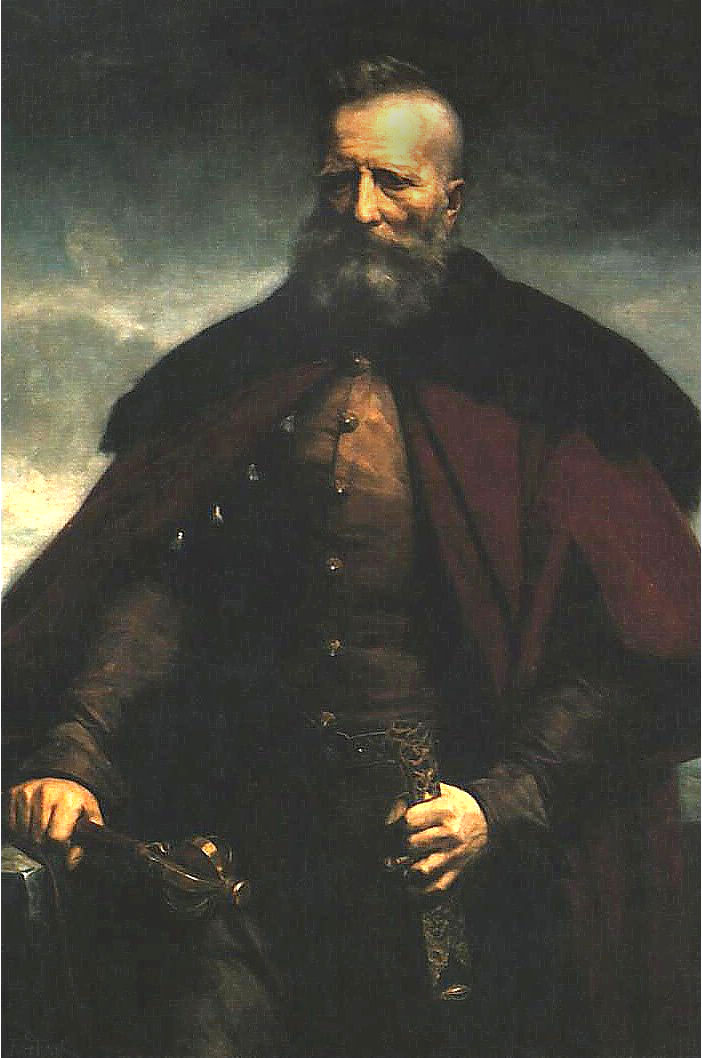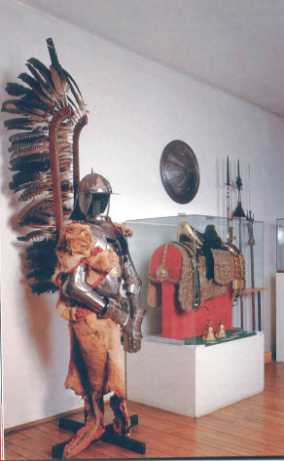 Jan
Karol Hadkevich
Jan
Karol Hadkevich(1560 - Sep. 24, 1621)
 Jan
Karol Hadkevich
Jan
Karol Hadkevich
(1560 - Sep.
24, 1621)
Jan
Karol Hadkevich (Chodkiewicz in Polish transcription) was born in 1560 and he
spent his childhood in the estate called Mysch, not far from Baranavichy.
Here, on the shores of the Myschanka river, his father’s solemn castle stood.
Its halls contained collections of old swords, sabers, shields and crossbows,
which attracted small Jan greatly. The boy was also inspired by the
coats-of-arms and portraits of his ancestors, who reached very high positions in
the Great principality of Lithuania and brought
glory to the ancient kin of Hadkevich.
In
those days young men from noble Belarusian families were to get good education.
Jan studied in Vilna - in college and academy, then in Germany and Italy, in the
city of Padua, where Francisk Skaryna once received the doctor’s degree in
medicine. Hadkevich knew history, geography, math well; he also spoke Latin
perfectly, in Europe it was the language of science and arts. When a child,
Hadkevich was keen on military games, and, having grown up, he decided to master
the secrets of war craft.
Jan
Karol was reading the famous captains’ works thoroughly; while reading these
works, he forgot about everything. To study the art of war, he also traveled
around Europe, in particular he visited Malta, where he got acquainted with the
experience of Maltese knights. Having returned to his homeland, Hadkevich
married Sophia, the young widow of prince Symon Slutsky. Jan gained his first
victories during the campaign in Moldavia and Valachia, being a commander of
private cavalry brigade. Soon, due to this success, he was made the field hetman
– a very high position in the army.
 Since 1600 Rzech Pospolita has been in the state of endless war with its
neighboring countries. Thus, because of the permanent war, the country
desperately needed experienced and highly professional army. Such army was the
hussar cavalry, under the command of one of the most prominent captains of our
land – Jan
Karol Hadkevich.
Since 1600 Rzech Pospolita has been in the state of endless war with its
neighboring countries. Thus, because of the permanent war, the country
desperately needed experienced and highly professional army. Such army was the
hussar cavalry, under the command of one of the most prominent captains of our
land – Jan
Karol Hadkevich.
…The hussar cavalry of the XVII century was heavy-armed and
represented the transitional stage between heavy knights and more modern kinds
of army. The hussars had certain wings fixed behind their backs (photo on the
left shows Hadkevich hussar armor in Malbork
castle museum). When a hussar
was moving fast on a horseback, these wings emitted sound which frightened
enemy’s horses.
Hadkevich’s hussars were highly experienced warriors, they were, so to say, the
special forces. Many a time the hussars defeated enemy’s armies which
outnumbered them.
…In
1600 the Great Prince and King Zhygimont Vaza made Hadkevich vice-great hetman
and sent him to the Baltic countries, where our countryman was destined to get
eternal glory.
In
1603 the Swedish garrison of Derpt (Tartu) capitulated. The year after Jan Karol
defeated strong enemy’s corps sent from the sea, and after some months he
celebrated another brilliant victory, having captured 21 enemy’s war banners.
After this the Council (Seim) of Rzech Pospolita
made Hadkevich great hetman. It meant that he became the leader of the
whole state’s army. But his main war triumphs were still ahead.
Belarusian
hussars helped hetman Hadkevich to defeat the Swedes on the 27th of
September, 1605. It was the battle near Kirchgolm (today- Salaspils) near Riga,
and the victory was almost fantastic. Swedish king Karl IX had 6840 footmen
(Scandinavian footmen were considered to be the best,) 450 horsemen and 11
cannons. 4350 soldiers and officers, including 3310 horsemen, stood under the
banners of Jan Hadkevich. Great hetman’s
forces almost totally consisted of the Belarusians. Almost all commander were
the Belarusians: Jan Peter Sapiega, Vincent Vojna, Jan Kischka, Tomasch Dubrova,
Martin Hedroytz… It is really hard to believe, but different historical
sources inform that almost 6000 Swedes died during the battle, while the losses
from our side were no more than 100
soldiers. The Pope of Rome and the majority of European monarchs congratulated
Hadkevich on this victory. But the Turkish Sultan didn’t do this, as if he had
predicted another great victory of our captain, this time over the 150 000 army
of the Turkey Porta at Hotin.
The religious Thirty Years War, which started in 1618 in Czechia, soon
occupied the whole Europe. King Zhygimont Waza was not an exception. After he
signed the alliance treaty with the Hapsburg dynasty, he became the enemy of
Turkey at once. In June of 1621 the huge Turkish army (up to 150 000 soldiers
total) moved North through Moldavia. The
purpose of the campaign was to conquer
the ways to the Baltic Sea. However, there was one hindrance on the way of the
Turks – Hotin, the powerful fortress built in the XV century by the Belarusian
craftsmen. The fortress was built by the command of prince Vitaut on the shore
of Dnestr river, near Chernovitsy, in Ukraine).
Getman Hadkevich was to defend Hotin. The army of Rzech Pospolita at Hotin was about 60
000 soldiers. There were Polish and Belarusian brigades,
also mercenaries from Prussia, Germany and Sylezia. But mostly the army
consisted of Zaporozhian Cossacks (30 000 soldiers.) The great hetman’s choice
was the defensive tactics.
On the 2nd of September the vanguards of the
100-kilometers-long Turkish army reached the walls of Hotin and tried to assault
the fortress at once and to capture it. But the garrison expected the enemy –
the hard combat began, and the Turks didn’t manage to please their Sultan. The
Turkish army itself reached the fortress on the 4th of September, and
after the bombardment of the fortress made by 60 Turkish cannons the assault
began. The vehement combat lasted all day long. In the evening mounted and foot
Cossacks managed to drive the Turks back and to attack the Turkish military
camp. Some cannons were captured. The Turks lost up to 3000 men during the
battle, the Cossacks lost about 800 men, the Belarusians and the Poles -
about 300 men. The 7th of September was one of the most
difficult days for the defenders of Hotin. The Turks have been bombarding and
assaulting the fortress all day long, and in the evening they entered the
fortress, having destroyed two brigades of the Poles and the Germans. The
Cossacks sent by Hadkevich drove the Turks behind the walls. But the Sultan decided not to let
the victory fly away, and he commanded his best janissaries to attack this part
of fortress once again. The defenders let the enemy come closer, then the gates
opened, and the Belarusian hussar cavalry brigades under the command of Nicolay
Senyawsky, Nicolay Zenowich, Peter Opalinsky, Jan Rudomina and Alexander Sapega
attacked the Turks. Getman Hadkevich himself led the hussars to battle. In spite of fanaticism and desperate
defense, the janissaries suffered great losses and had to retreat. So, this was
the day when the Sultan decided not to assault the fortress anymore, the Turks
blocked Hotin and started massaged bombardment of the fortress.
The defenders of Hotin died not only from Turkish shots, but also from
hunger and diseases. To get the provision, at nights the Cossacks had to make
sallies to the enemy’s camp. The Turks were also in awful conditions. Great
losses in battles, cold rains, hunger and fugitive acts disrupted the fighting
spirit of the Turks. In the beginning of the battle Osman II proclaimed that he
would eat no sooner than the fortress of the infidels gave up. Now nobody
recalled this fact. It looked that sad war elephants were not destined to see
the waves of the Baltic Sea.
On
the 18th of September hetman Hadkevich, who has already been mortally
ill, gathered the officers’ council. The main problem was whether to keep on
defending or give up. It was decided to keep on defending Hatin.
The number of soldiers decreased, so, to decrease the defense line, new
bulwarks were built closer to the citadel. On the 24th of September hetman
Hadkevich died. This became known to the Turks. Being inspired by the news about
the death of the famous captain, the janissaries attacked the fortress
violently. Hard combat began on the walls of the fortress. But the Cossacks
stood to death against the enemy. Again and again the Turks attacked the walls
and, suffering great losses, were driven back. Finally, the determination to
assault the fortress vanished totally. The treaty discussions began, which ended
on the 9th of October. According to the peace treaty signed, the
borders of the country remained unchanged. It was a GREAT VICTORY…
Text by Mr. Alexander Kokosha and his son.
Links related to Jan Karol Hadkevich:
Lyahovichy Castle built by Hadkevich
Hetman Jan Karol Hodkiewicz on Polish stamps printed during Solidarnosc days.
Jan Karol Hadkevich page on Wikipedia
Jan Karol Hadkevich page on Britannica
Gregory Hadkevich page on Wikipedia
Other Relevant Pages of the Virtual Guide to Belarus
![]() Belarusian Castles and
Knighthood
Belarusian Castles and
Knighthood
![]() Historic Belarusian Battles
Historic Belarusian Battles
![]() Belarusian
Statehood
Belarusian
Statehood
![]() History
of Belarus
History
of Belarus
 The Belarusian Cities guide is a part of the Virtual Guide to Belarus - a
collaborative project of Belarusian scientists
abroad. VG brings you the most extensive compilation of the information about Belarus on
the Web.
The Belarusian Cities guide is a part of the Virtual Guide to Belarus - a
collaborative project of Belarusian scientists
abroad. VG brings you the most extensive compilation of the information about Belarus on
the Web.
Please send your comments to the authors of VG to
Belarus
History | Statehood | Culture | Law and Politics | Cities | Nature and Geography
|